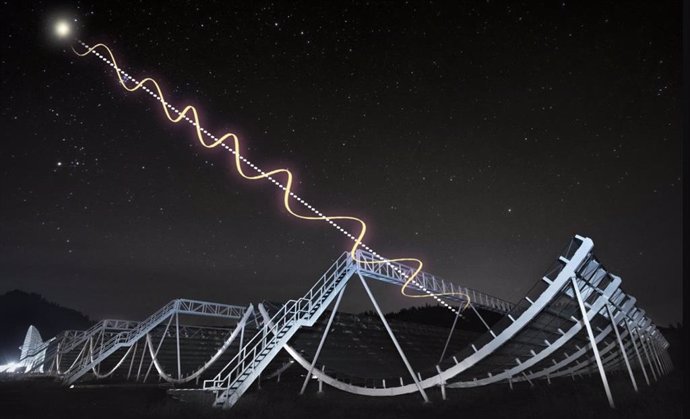
An artistic demonstration of how the angle of polarized light from an FRB changes as it travels through space. – Dunlap Institute.
Madrid, June 11 (European Press) –
What scientists believe so far about the origin of the mysterious cosmic signal FRB (fast radio burst) is just that Tip of the icebergThis is according to a study conducted by the University of Toronto.
The mysteries of millisecond cosmic explosions have been solved using a new method of analyzing data from the Canadian Hydrogen Intensity Mapping Experiment (CHIME).
Published in Astrophysical JournalThe study details the properties of polarized light from 128 non-repeating fast bursts (that is, from sources that have produced only one burst so far). The study found that they appear to come from galaxies like our own Milky Way, with modest densities and magnetic fields.
Previous FRB studies have focused on much smaller samples of hyperactive repetitive sources which, in contrast, They appear to originate in dense, highly magnetized environments. Only about 3% of known FRBs are repetitive and come from a source that has produced several bursts since their discovery.
Most radio telescopes can see only small points in the sky, making it easier to focus on repeating fast radio bursts with known positions. CHIME can scan a very large area of the sky to detect both recurring and infrequent fast radio bursts.
“This was the first look at the other 97%,” he says. It’s a statement Lead author Aayush Pandey, a doctoral student in the Dunlap Institute for Astronomy and Astrophysics and the David A. Dunlap School of Astronomy and Astrophysics at the University of Toronto.
“It allows us to reconsider what we think about fast radio bursts “And see how recurring and non-repeating fast radio bursts differ.”
Cosmic puzzle
Fast radio bursts, first discovered in 2007, are extremely energetic flashes that come from distant sources throughout the universe. While more than 1,000 FRBs have been cataloged since then, scientists still don’t know exactly where or how they are produced. They also wondered whether recurring and non-repeating fast radio bursts arise in similar environments.
“This is a new way to analyze the data we have on fast radio bursts,” Pandey says. “Instead of just looking at how bright something is, we also look at the angle of the electromagnetic waves vibrating the light.” “It gives you additional information about how and where that light is produced,” Why did it pass through millions of light years on its journey to us?“.
All light travels in waves that we interpret as different colors depending on the lengths between their peaks and valleys. Much of the light in the universe travels at wavelengths that the human eye cannot see, including light from fast radio bursts (FRBs), but radio telescopes like CHIME can.
Polarized light consists of waves that vibrate in one plane: vertically, horizontally, or some other angle in between. It has been observed that the direction in which light from fast radio bursts is polarized changes in two ways: with time and with the color of the light. These changes may explain how fast radio bursts are produced and what type of matter they pass through on their journey to Earth.
Studying how the direction of polarization changes for different colors of light can tell us the local density of where fast radio bursts are produced and the strength of the magnetism there.
To determine what fast radio bursts are and how they are produced, scientists need to understand their local environments. This study concluded that the majority of fast radio bursts, those that do not repeat, are not like the few recurring sources that have been studied previously. It indicates that this sample is a separate population or more evolved versions of the same emerging population In a less harsh environment with a lower explosion rate.
Collaborating institutions include the Dunlap Institute at the University of Toronto, the University of California at Santa Cruz, the University of Amsterdam, and McGill University.
The CHIME project is co-led by the University of British Columbia, McGill University, the University of Toronto, and the Dominion Radio Astrophysical Observatory with collaborating institutions across North America.
It is located at the Dominion Radio Astrophysical Observatory, an astronomy facility operated by the National Research Council of Canada.

“Beer enthusiast. Subtly charming alcohol junkie. Wannabe internet buff. Typical pop culture lover.”
